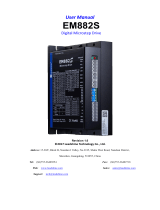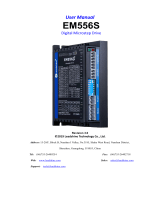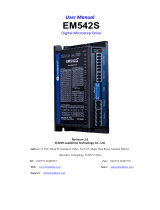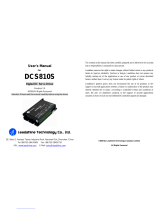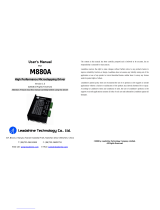Page is loading ...

CS1-D507S
Closed Loop Stepper Drive
User Manual
Revision 1.0
©2019 Leadshine Technology Co., Ltd.
Address: 15-20/F, Block B, Nanshan I Valley, No.3185, Shahe West Road, Nanshan District,
Shenzhen, Guangdong, 518055, China
Tel: (86)755-26409254 Fax: (86)755-26402718
Web: www.leadshine.com Sales: sales@leadshine.com
Support: tech@leadshine.com

CS1-D507S Closed Loop Stepper Drive User Manual
Notice
Read this manual carefully before any assembling and using. Incorrect handling of products in this manual can result in
injury and damage to persons and machinery. Strictly adhere to the technical information regarding installation
requirements.
This manual is not for use or disclosure outside of Leadshine except under permission. All rights are reserved. No part
of this manual shall be reproduced, stored in retrieval form, or transmitted by any means, electronic, mechanical,
photocopying, recording, or otherwise without approval from Leadshine. While every precaution has been taken in the
preparation of the book, Leadshine assumes no responsibility for errors or omissions. Neither is any liability assumed
for damages resulting from the use of the information contained herein.
This document is proprietary information of Leadshine that is furnished for customer use ONLY. Information in this
document is subject to change without notice and does not represent a commitment on the part of Leadshine. Therefore,
information contained in this manual may be updated from time-to-time due to product improvements, etc., and may
not conform in every respect to former issues.
Record of Revisions
Revision
Date
Description of Release
1.00
Aug, 2019
Initial Release
1.1
Mar, 2020
Modified the configuration of S1 rotating switch;

CS1-D507S Closed Loop Stepper Drive User Manual
Table of Content
1. Introduction.......................................................................................................................................................................1
1.1 Features...................................................................................................................................................................1
1.2 Applications............................................................................................................................................................ 2
2. Specifications....................................................................................................................................................................2
2.1 Electrical Specifications......................................................................................................................................... 2
2.2 Environment............................................................................................................................................................2
2.3 Mechanical Specifications......................................................................................................................................3
2.4 Heat Dissipation......................................................................................................................................................3
3. Connections and LED Indication..................................................................................................................................... 4
3.1 P1 – Control and Digital Output Connections....................................................................................................... 4
3.2 P2 - Encoder Signal Input Connector.....................................................................................................................6
3.3 P3 - Motor Connector............................................................................................................................................. 6
3.4 P4 - Power Connector.............................................................................................................................................6
3.5 P5 - Tuning Port......................................................................................................................................................7
3.6 Status LED Lights...................................................................................................................................................7
3.7 Switches..................................................................................................................................................................7
4. Motor Selection.................................................................................................................................................................8
5. Power Supply Selection....................................................................................................................................................8
5.1 Regulated or Unregulated Power Supply............................................................................................................... 8
5.2 Power Supply Sharing............................................................................................................................................ 8
5.3 Selecting Supply Voltage........................................................................................................................................8
6.Switch Configurations....................................................................................................................................................... 9
6.1 S1 - Rotating Switch Configurations......................................................................................................................9
6.2 S2 - DIP Switch Configurations............................................................................................................................. 9
6.2.1 Micro Step (SW1-SW4)............................................................................................................................ 10
6.2.2 Mode Setting (SW5 - SW8).......................................................................................................................11

CS1-D507S Closed Loop Stepper Drive User Manual
6.2.3 Smoothing Filter Time Configuration (SW9-SW10)................................................................................11
6.2.4 Encoder Resolution Configuration (SW11-SW12)...................................................................................11
6.3 S3 - Selector Switch Configurations.................................................................................................................... 12
7. Typical Connection......................................................................................................................................................... 12
7.1 Digital Input Connection...................................................................................................................................... 13
7.2 Digital Output Connection....................................................................................................................................14
7.2.1 In position and Fault Output Connection.................................................................................................. 14
7.2.2 Encoder Output Connection...................................................................................................................... 14
7.2.3 Brake Output Connection.......................................................................................................................... 14
8. Sequence Chart of Control Signals.................................................................................................................................14
9. Fault Protections............................................................................................................................................................. 15
10. Software Configuration................................................................................................................................................ 16
11. Accessories....................................................................................................................................................................16
12. Troubleshooting............................................................................................................................................................ 16
13. Warranty........................................................................................................................................................................19

CS1-D507S Closed Loop Stepper Drive User Manual
Page | 1
1. Introduction
Leadshine CS1-D507S are closed loop stepper drives designed to solve the loss of step problem in open loop stepper
control systems, thus increase system reliability at minimal cost increase. It implements advanced control algorithm of
Leadshine based on its tens of years’ experience in stepper and servo controls. The CS1-D507S are highly reliable and
affordable and performs excellent in many industrial applications such as CNC, medical, electronics, packaging...
The CS1-D507S can power 2-phase NEMA 17, 23, and 24 stepper motors with incremental encoders. Compared with
traditional open loop stepper systems, the CS1-D507S adopted closed loop step system can eliminate potential loss of
step, make real-time position error correction, and do not need torque reservation (100% torque implementation). Also
it can power the driven stepper motor with reduced heating, lower noise, low vibration…
1.1 Features
No loss of step
No torque reservation
No hunting or overshooting
No tuning for easy setup
Enhance performance at low speed application( 30-120 RPM)
20-50VDC supply voltage, max 7A output current
Max 500 KHz input frequency
Brake output does not need to connect a relay
Inputs and Outputs
●Step & DIR (CW & CCW) inputs
●Enable input and Error Reset input
●Alarm output and In Position output
●Brake outputs
●Encoder A/B/Z outputs
Switch Setting
●Microstep resolution
●Rotation direction
●Pulse Mode
●Positional command filter
●Closed / Open Loop Mode
●Encoder resolution
●Gain adjustment and output current
●5V or 24V control signal voltage selector
Protections
●Over current
●Over voltage
●Motor connection error
●Encoder connection error
●Position following error
●ROM error
●Auto-tuning error
Software Tuning
●Output current
●Input/Output signals level
●Motion parameters
●Brake parameters

CS1-D507S Closed Loop Stepper Drive User Manual
Page | 2
1.2 Applications
When a CS1-D507S closed loop stepper drive is implemented with a compatible stepper motor with encoder, the
closed stepper system can be adopted in many small to median speed applications such as CNC routers, CNC mills,
CNC laser cutters, CNC plasma, lab automation instruments, plotters, medical equipment, electronic equipment, small
packaging machines, etc.
2. Specifications
2.1 Electrical Specifications
Parameters
Min
Typical
Max
Unit
Peak Current
0.5
6.0
7.0 (Peak)
A
Operating Voltage
20
24, 36, 48
50
VDC
Logic input signal current
7
10
16
mA
Pulse input frequency
0
-
500
kHz
Brake output signal current
-
-
500
mA
Alarm output voltage
-
-
24
VDC
Minimal pulse width
1.0
-
-
μS
Minimal direction setup
2.0
-
-
μS
Isolation resistance
500
MΩ
2.2 Environment
Cooling
Natural Cooling or Forced Cooling
Operating Environment
Environment
Avoid dust, oil fog and corrosive gases
Humidity
40%RH-90%RH
Operating Temperature
0°C -50°C (32°F - 122°F)
Vibration
10-50Hz / 0.15mm
Storage Temperature
-20°C -65°C (-4°F - 149°F)
Weight
Approx. 280 g (9.9 Oz)

CS1-D507S Closed Loop Stepper Drive User Manual
Page | 3
2.3 Mechanical Specifications
(unit: mm [1inch=25.4mm])
Figure 1: Mechanical specifications
2.4 Heat Dissipation
CS1-D507S reliable working temperature should be no more than 60℃(140°F)
It is recommended to mount the drive vertically to maximize heat dissipation. Mount a cooling fan nearby if
necessary.
If multiple CS1-D507S drives are installed, it is suggested to keep a minimal 30mm (12 inches) between two of
them.

CS1-D507S Closed Loop Stepper Drive User Manual
Page | 4
3. Connections and LED Indication
A CS1-D507S closed loop stepper drive has 5 connection blocks from P1 to P5 (see figure 2).
Figure 2: CS1-D507S connectors
3.1 P1 – Control and Digital Output Connections
The P1 connector in Figure 2 contains connections for control signals and a configurable digital output.
See the following table for details.
PIN
I/O
Details
PUL+
(CW+)
I
Pulse and Direction Connection:
(1) Optically isolated, high level 3.5-5V or 24V, low voltage 0-0.5V
(2) Maximum 500 KHz input frequency
(3) The width of PUL signal is at least 1.0μs, duty cycle is recommended 50%
(4) Single pulse (step & direction) or double pulse (CW/CCW) is set by DIP Switch SW7
(5) DIR signal requires advance PUL signal minimum 2 μs in single pulse mode
(6) The factory setting of control signal voltage is 24V, must need to set S3 (figure 2) if it is 5V
PUL-
(CW-)
I
DIR+
(CCW+)
I
DIR-
(CCW-)
I

CS1-D507S Closed Loop Stepper Drive User Manual
Page | 5
RST
I
Alarm Reset and Enable Signals: Optional.
(1) RST means alarm reset, ENA means Enable. Optically isolated, single-ended.
(2) RST and ENA: Effective high level is 3.5-24V; Effective low level is 0-0.5V connection
(3) RST signal can clear the alarm of “Position following error” and “Fail to lock motor shaft” ,
other alarms require the power supply to be restarted
(4) ENA signal requires advance DIR signal minimum 2μs in single pulse mode, (default no
connection)
ENA
I
COMI
I
Common connection of single-end input signals (common-cathode and common-anode)
COMO
O
Common connection of single-end output signals (common-cathode)
PEND
O
In Position and Alarm : They takes a sinking or sourcing 100mA current at 5-24V. Max 30V
ALM
O
EAO+
O
Encoder A+ output
EAO-
O
Encoder A- output
EBO+
O
Encoder B+ output
EBO-
O
Encoder B- output
EZO+
O
Encoder Z +/- output, optional. Only if the closed-loop motor has Z signal input to CS1-D507S,
the CS1-D507S will have Z signal output to controller or PLC
EZO-
O
24VB
I
Used for brake signal, connect with +24 DC of external power supply, refer to chapter 7.2.3
BRK+
O
Brake+ signal, Max. 24/500mA, connect with brake coil.
BRK-
O
Brake- signal, Max. 24/500mA, connect with brake coil. It’s shown as SO7 in Leadshine
ProTuner and level cannot be modified
S-GND
O
Signal GND
Notes: (1) Shielding control signal wires is suggested; (2) To avoid/reduce interference, don’t tie control signal cables
and power wires together; (3) Brake output does not need to connect a relay

CS1-D507S Closed Loop Stepper Drive User Manual
Page | 6
3.2 P2 - Encoder Signal Input Connector
The P2 connector in Figure 2 is for encoder signal connection. Refer to the following table for details.
Drive Pin Name
Description
NC
No connection
VCC
+5V voltage for encoder
GND
Power ground connection
EZ+
Encoder Z+ input connection
EZ-
Encoder Z- input connection
EB+
Encoder B+ input connection
EB-
Encoder B- input connection
EA+
Encoder A+ input connection
EA-
Encoder A- input connection
3.3 P3 - Motor Connector
PIN
Details
A+
Connect to motor A+ wire
A-
Connect to motor A- wire
B+
Connect to motor B+ wire
B-
Connect to motor B- wire
3.4 P4 - Power Connector
Pin
Details
GND
Connect to power supply ground connection.
+VDC
Connect to power supply positive connection. Suggest 24-48VDC power supply voltage
!
Warning
Warning: Don’t plug/unplug P3 or P4 connector to avoid drive damage or injury while powered on.

CS1-D507S Closed Loop Stepper Drive User Manual
Page | 7
3.5 P5 - Tuning Port
CS1 series has a tuning port with RS232 to modify the drive parameters, it’s only for tuning, not for equipment control
because neither precision nor stability is sufficient. If you need a field bus drive, use a Leadshine RS485 or EtherCAT
type drives:
http://www.leadshine.com/ProductSubType.aspx?type=products&category=stepper-products&producttype=stepper-dri
ves&subtype=network-stepper-drives
The interface definition is as follows:
Figure 3: CABLE-PC-1 connectors
3.6 Status LED Lights
There are two LED lights for CS1 Series. The GREEN one is the power indicator which should be always on in normal
circumstance. The RED one is a drive status indication light, which will be OFF while working normally but ON and
flash 1 or 2 times in a 3-second period in the case of enabled over-current or over-voltage protection.
3.7 Switches
The CS1-D507S has one rotating switch, one 12-bit DIP switch and one 1-bit selector switch.
Switch
Pic
Details
Rotating
switch S1
Drive Peak Current and Gain adjustment
DIP
switch S2
Microstep resolution
Rotation direction
Pulse Mode
Positional command filter
Closed / Open Loop Mode
Encoder resolution
Selector
switch S3
5V or 24V control signal voltage selector.
The factory setting is 24V, must need to set S3 to 5V if
the control signal voltage is 5V

CS1-D507S Closed Loop Stepper Drive User Manual
Page | 8
4. Motor Selection
The CS1-D507S are designed to power 2-phase NEMA 17/23/24 stepper motors under 10000-line incremental
encoders. Leadshine offers many high performance closed loop stepper motors.
Notes: Default closed-loop stepper motors is equipped with a 1000-line incremental encoder without Z signal, contact
Leadshine for stepper motor with 2500-line, 5000-line encoders and with Z ( Index) signal.
5. Power Supply Selection
The CS1-D507S can power small and medium size closed loop stepper motors (frame size from NEMA17 to 24) from
Leadshine. To get good system performance, it is important to select proper supply voltage and output current.
Generally speaking, supply voltage determines the high speed performance of the motor, while output current
determines the output torque of the driven motor (particularly at lower speed). Higher supply voltage will allow higher
motor speed to be achieved, at the price of more noise and heating. If the motion speed requirement is low, it’s better to
use lower supply voltage to decrease noise, heating and improve reliability.
5.1 Regulated or Unregulated Power Supply
Both regulated and unregulated power supplies can be used to supply the drive. However, unregulated power supplies
are preferred due to their ability to withstand current surge and fast response for current change. If you prefer to a
regulated power supply, it is suggested to choose such a power supply specially designed for stepper/servo controls
such as Leadshine RPS series (http://www.leadshine.com/producttypes.aspx?producttype=regulated-switching). Or, in
the case when only normal switching power supplies are available, it is important to use “OVERSIZE” high current
output rating power supplies (for example, using a 4A power supply for 3A stepper motor) to avoid problems such as
current clamp. On the other hand, if unregulated supply is used, one may use a power supply of lower current rating
than that of motor (typically 50%-70% of motor current). The reason is that the drive draws current from the power
supply capacitor of the unregulated supply only during the ON duration of the PWM cycle, but not during the OFF
duration. Therefore, the average current withdrawn from power supply is considerably less than motor current. For
example, two 3A motors can be well supplied by one power supply of 4A rating.
5.2 Power Supply Sharing
Multiple CS1-D507S drives can share one power supply to save space and reduce cost, if that power supply has
enough power capacity. To avoid cross interference, connect each stepper drive directly to the shared power supply
separately. To avoid cross interference, DO NOT daisy-chain connect the power supply input pins of the Drivers.
Instead connect them to power supply separately.
5.3 Selecting Supply Voltage
The CS1-D507S are designed to operate within 20-50VDC voltage input. When selecting a power supply, besides
voltage from the power supply power line voltage fluctuation and back EMF voltage generated during motor
deceleration needs also to be taken into account. Ideally it is suggested to use a power supply with the output of
20-48VDC, leaving room for power line voltage fluctuation and back-EMF.

CS1-D507S Closed Loop Stepper Drive User Manual
Page | 9
Higher supply voltage can increase motor torque at higher speeds, thus helpful for avoiding losing steps. However,
higher voltage may cause bigger motor vibration at lower speed, and it may also cause over-voltage protection or even
drive damage. Therefore, it is suggested to choose only sufficiently high supply voltage for intended applications.
6. Switch Configurations
The CS1 series has one rotating switch, one 12-bit DIP switch and one 1-bit selector switch. “Default” means that
parameters can be modified by Leadshine PC software software, “Factory” means that factory setting, suitable for most
customer applications
6.1 S1 - Rotating Switch Configurations
This rotating switch is used to set the peak current of the drive and motion gain, from the motor phase current and
application requirements. When the rotating switch code is set to 8, the user can modify the drive peak current value
and Kp & Ki value through Leadshine PC software.
Peak
Current
Code
Velocity
loop Ki
Position
loop Kp
Velocity
loop Kp
Remark
4.0A
0
0
25
25
1) Recommended motors are CS-M22306 and
CS-M22313;
2) Velocity loop Ki Indicates the stop time and
position accuracy , “0” indicates the stop time
is long, but the position error is smaller.“16”
means the stop time is short, but the position
error is slightly larger.
3) Position loop Kp and velocity loop Kp is a
pair of composite parameters that represent
rigidity. “25” and “25”composite parameters
indicate the rigidity is weak, “100” and “5”
composite parameters indicate the rigidity is
strong.
4) Usually keep factory settings
1
0
50
15
2
0
75
10
3
0
100
5
4
16
25
25
5
16
50
15
6
16
75
10
7
16
100
5
6.0A
8(default &
factory)
0
25
25
1) Recommended motors are CS-M22323,
CS-M22326, CS-M22331-L, CS-M22422 and
CS-M22430;
2) Velocity loop Ki Indicates the stop time and
position accuracy , “0” indicates the stop time
is long, but the position error is smaller.“16”
means the stop time is short, but the position
error is slightly larger.
3) Position loop Kp and velocity loop Kp is a
pair of composite parameters that represent
rigidity. “25” and “25”composite parameters
indicate the rigidity is weak, “100” and “5”
composite parameters indicate the rigidity is
strong.
4) Usually keep factory settings
9
0
50
15
A
0
75
10
B
0
100
5
C
16
25
25
D
16
50
15
E
16
75
10
F
16
100
5

CS1-D507S Closed Loop Stepper Drive User Manual
Page | 10
6.2 S2 - DIP Switch Configurations
The 12-bit is located on the side (DIP switch S2 in Figure 2) and used to configure settings of micro step resolution,
output current, and motor standstill current as shown below, the factory setting of SW1-SW12 is ON, OFF, OFF, ON,
OFF, OFF, ON, OFF, OFF, OFF, OFF, OFF.
SW1
SW2
SW3
SW4
SW5
SW6
SW7
SW8
SW9
SW10
SW11
SW12
Figure 4: DIP switches
6.2.1 Micro Step (SW1-SW4)
Each CS1-D507S has 8 micro step settings which can be configured through DIP switch SW1, SW2, SW3 and SW4.
See the following table for detail. When they are set to ON, ON, ON,ON, the microstep can be set via Leadshine PC
software.
Micro step
Pulses/Rev. (for 1.8°motor)
SW1
SW2
SW3
SW4
2
400 (default)
ON
ON
ON
ON
5
1000
OFF
ON
ON
ON
8
1600
ON
OFF
ON
ON
10
2000
OFF
OFF
ON
ON
16
3200
ON
ON
OFF
ON
18
3600
OFF
ON
OFF
ON
20
4000 (factory)
ON
OFF
OFF
ON
25
5000
OFF
OFF
OFF
ON
32
6400
ON
ON
ON
OFF
40
8000
OFF
ON
ON
OFF
50
10000
ON
OFF
ON
OFF
100
20000
OFF
OFF
ON
OFF
125
25000
ON
ON
OFF
OFF
180
36000
OFF
ON
OFF
OFF
200
40000
ON
OFF
OFF
OFF
250
50000
OFF
OFF
OFF
OFF
No Auto tuning
Encoder resolution
Rotation direction
Microstep
Pulse mode
Control mode
Smoothing filter time

CS1-D507S Closed Loop Stepper Drive User Manual
Page | 11
6.2.2 Mode Setting (SW5 - SW8)
Function
ON
OFF
SW5
Rotation Direction
CW (clockwise)
CCW (counterclockwise)
SW6
No Auto Tuning
Enable
Disable
SW7
Pulse Mode
CW/CCW (double pulse)
PUL/DIR (single pulse)
SW8
Control Mode
Open loop control
Closed loop control
6.2.3 Smoothing Filter Time Configuration (SW9-SW10)
CS1-D507S has an advanced feature called control command smoothing to make the input pulse from pulse generator
(controller, PLC, etc.) S-curve acceleration, to improve motion smoothness and high-speed start frequency in many
circumstances.
This is achieved through adding filtering time which is configured SW9-SW10. See the following table for how to
configure. When SW9-SW10 setting is OFF, OFF, the filtering time can be set by Leadshine PC software.
Filter Time
SW9
SW10
1.5 ms (default and factory)
OFF
OFF
3 ms
OFF
ON
12 ms
ON
OFF
37 ms
ON
ON
!
Warning
The Filter Time value must be set to the same for each CS1-D507S in multi-axis applications
6.2.4 Encoder Resolution Configuration (SW11-SW12)
CS1-D507S can power closed loop stepper motors with incremental encoders (include and under 5000 ppr resolution ) ,
it has 2-bit DIP switch to set motor encoder resolution as below, When SW11-SW12 setting is ON, ON, the encoder
resolution can be set by Leadshine PC software.
Encoder Resolution (ppr)
Count per Rev. (cpr)
SW11
SW12
1000
4000 (default)
ON
ON
2000
8000
OFF
ON
5000
20000
ON
OFF
2500
10000 (factory)
OFF
OFF

CS1-D507S Closed Loop Stepper Drive User Manual
Page | 12
6.3 S3 - Selector Switch Configurations
The 1-bit selector is located on the top (S3 in figure 2), used to configure the voltage of control signals. For the safety
of optically coupled, the factory setting is 24V, which no need to connect 2K resistors, making it easier to use. When
the voltage of the control signal is 5V, the S3 must be set to 5V, otherwise, the motor won't work.
7. Typical Connection
A complete closed loop stepper system should include a stepper motor with encoder, CS1-D507S drive, power supply
and controller (pulse generator). A typical connection is as below.
Figure 5: Typical connection
Notes: (1) If need Z signal output, please contact Leadshine for the motor and encoder extension cable with Z signal.
(2) Pulse and direction inputs level 5V or 24V selected by selector switch S3. When it is 24 V, the S3 selection of 5V
will damage the input photo-coupling.
(3) Enable (ENA) and alarm reset (RST) signal is 5V~24V compatible.

CS1-D507S Closed Loop Stepper Drive User Manual
Page | 13
7.1 Digital Input Connection
Figure 6: Digital input connections

CS1-D507S Closed Loop Stepper Drive User Manual
Page | 14
7.2 Digital Output Connection
7.2.1 In position and Fault Output Connection
The PEND (In-position) and ALM (Alarm) can be connected either in sinking or sourcing as below:
Figure 7 Sinking output Figure 8 Sourcing output
7.2.2 Encoder Output Connection
The CS1-D507S has push-pull differential encoder output signals (EA+/-, EB+/-, EZ+/-), with AM26LS31 line driver,
required current is ±20mA, can be connected to the upper controller to feedback the position information of the
motor.
Figure 9 Encoder signals output
7.2.3 Brake Output Connection
This drive has a special brake output, built-in a fly-wheel diode, driving current up to 500 mA, can directly drive the
motor brake without relays. The connection is below:
Figure 10 Brake output connection
8. Sequence Chart of Control Signals
In order to avoid some fault operations and deviations, PUL, DIR and ENA should abide by some rules, shown as
following diagram:

CS1-D507S Closed Loop Stepper Drive User Manual
Page | 15
Figure 11: Sequence chart of control signals
Remark:
a) t1: ENA must be ahead of DIR by at least 300ms. Usually, ENA+ and ENA- are NC (not connected). See
“Connector P1 Configurations” for more information.
b) t2: DIR must be ahead of PUL effective edge by 2us to ensure correct direction;
c) t3: Pulse width not less than 1us;
d) t4: Low level width not less than 1us;
e) Duty cycle of PUL signal is recommended 50%.
9. Fault Protections
To improve reliability, the drive incorporates some built-in protection features.
Blink
time(s)
Sequence wave of red LED
Description
Trouble shooting
1
0.2S
5S
Over-current
Turn off the power immediately.
a) Check wiring is short-circuited or not;
b) Check motor is short-circuited or not.
2
0.2S
0.3S
5S
Over-voltage
Turn off the power immediately.
a) Check if the power voltage is higher
than 90VDC
3
Chip error
Restart the power supply, if the drive is
still alarm, please contact after-sale
4
Fail to lock motor
shaft
a) The drive is not connected to a motor;
b) If alarm is occurred when connect a
motor , set DIP switch SW6 to ‘on’ and
restart power supply; If it still alarm,
please check the motor power cable.

CS1-D507S Closed Loop Stepper Drive User Manual
Page | 16
5
EEPROM error
Restart the power supply, if the drive is
still alarm, please contact after-sale
6
Fail to auto tuning
Set DIP switch SW6 to ‘on’
7
0.2S
0.3S
5S
Position following
error
a) The value of position following error
is set too small;
b) Motor torque is not enough or motor
speed is too high;
c) Motor wiring error, check wiring
Always
-
PCB board is
burned out
Contact after-sale
a) Power supply connection is wrong
When above protections are active, the motor shaft will be free or the red LED blinks. Reset the drive by repowering it
to make it function properly after removing above problems.
10. Software Configuration
The CS1-D507S is designed for simple setup and implementation. For most applications no software configuration or
tuning is needed especially when driving Leadshine stepper motors with encoders. If you want to do fine tuning or
custom configurations such as micro-step, current percentage change…, you can use Leadshine’s free ProTuner
software to make the changes.
11. Accessories
If you plan to use the ProTuner software, contact your supplier or Leadshine to purchase the RS232 cable with part
number CABLE-PC-1 for connecting the CS1-D507S to a computer with Windows 7/8/10 installed. In the case of
using USB to RS232 conversion, contact your supplier or Leadshine for such a cable with part number USB2.0-232
which has been verified working fine.
CABLE-PC-1 USB2.0-232
(RS232 tuning cable) (USB to RS232 Conversion Cable)
12. Troubleshooting
In the event that your drive doesn’t operate properly, the first step is to identify whether the problem is electrical or
/


